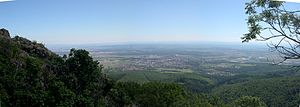
Back Elsas Afrikaans Elsass ALS አልሳስ Amharic Alsacia AN Elsass ANG ألزس Arabic Alsacia AST Alsace suyu Aymara Elzas Azerbaijani آلزاس AZB
This article needs additional citations for verification. (August 2022) |
Alsace
Elsàss (Alemannic German) | |
|---|---|
| Anthem: "Elsässisches Fahnenlied" (German) (English: "Song of the Alsatian Flag") | |
 | |
| Country | France |
| Territorial collectivity | European Collectivity of Alsace |
| Prefecture | Strasbourg |
| Departments | |
| Area | |
| • Total | 8,280 km2 (3,200 sq mi) |
| Population (Jan. 2021)[3] | |
| • Total | 1,919,745 |
| • Density | 230/km2 (600/sq mi) |
| Demonym | Alsatian |
| GDP | |
| • Total | €67.748 billion (2022) |
| • Per capita | €35,800 (2022) |
| ISO 3166 code | FR-A |
| Part of a series on |
| Alsace |
|---|
|
|
Alsace (/ælˈsæs/,[5] US also /ælˈseɪs, ˈælsæs/;[6][7] French: [alzas] ⓘ; Low Alemannic German/Alsatian: Elsàss [ˈɛlsɑs]; German: Elsass (German spelling before 1996: Elsaß.) [ˈɛlzas] ⓘ; Latin: Alsatia) is a cultural region and a territorial collectivity in eastern France, on the west bank of the upper Rhine next to Germany and Switzerland. In January 2021, it had a population of 1,919,745.[3] Alsatian culture is characterized by a blend of German and French influences.[8]
Until 1871, Alsace included the area now known as the Territoire de Belfort, which formed its southernmost part. From 1982 to 2016, Alsace was the smallest administrative région in metropolitan France, consisting of the Bas-Rhin and Haut-Rhin departments. Territorial reform passed by the French Parliament in 2014 resulted in the merger of the Alsace administrative region with Champagne-Ardenne and Lorraine to form Grand Est. On 1 January 2021, the departments of Bas-Rhin and Haut-Rhin merged into the new European Collectivity of Alsace but remained part of the region Grand Est.
Alsatian is an Alemannic dialect closely related to Swabian, although since World War II most Alsatians primarily speak French. Internal and international migration since 1945 has also changed the ethnolinguistic composition of Alsace. For more than 300 years, from the Thirty Years' War to World War II, the political status of Alsace was heavily contested between France and various German states in wars and diplomatic conferences. The economic and cultural capital of Alsace, as well as its largest city, is Strasbourg, which sits on the present German international border. The city is the seat of several international organizations and bodies.
- ^ "Elsässisches Fahnenlied [Anthem of Alsace][+English translation]". YouTube.
- ^ "La géographie de l'Alsace". region.alsace. Archived from the original on 12 December 2015. Retrieved 13 January 2016.
- ^ a b Combined 2021 population of the departements of Bas-Rhin and Haut-Rhin: "Populations légales des départements en 2021". INSEE. Retrieved 16 January 2024.
- ^ "EU regions by GDP, Eurostat". Retrieved 18 September 2023.
- ^ "Alsace". Lexico UK English Dictionary. Oxford University Press. Archived from the original on 17 March 2020.
- ^ "Alsace". The American Heritage Dictionary of the English Language (5th ed.). HarperCollins. Retrieved 11 May 2019.
- ^ "Alsace". CollinsDictionary.com. HarperCollins. Retrieved 11 May 2019.
- ^ Leichtfried, Laura (23 February 2017). "Alsace: culturally not quite French, not quite German". British Council. Archived from the original on 23 February 2017. Retrieved 25 August 2021.
© MMXXIII Rich X Search. We shall prevail. All rights reserved. Rich X Search







